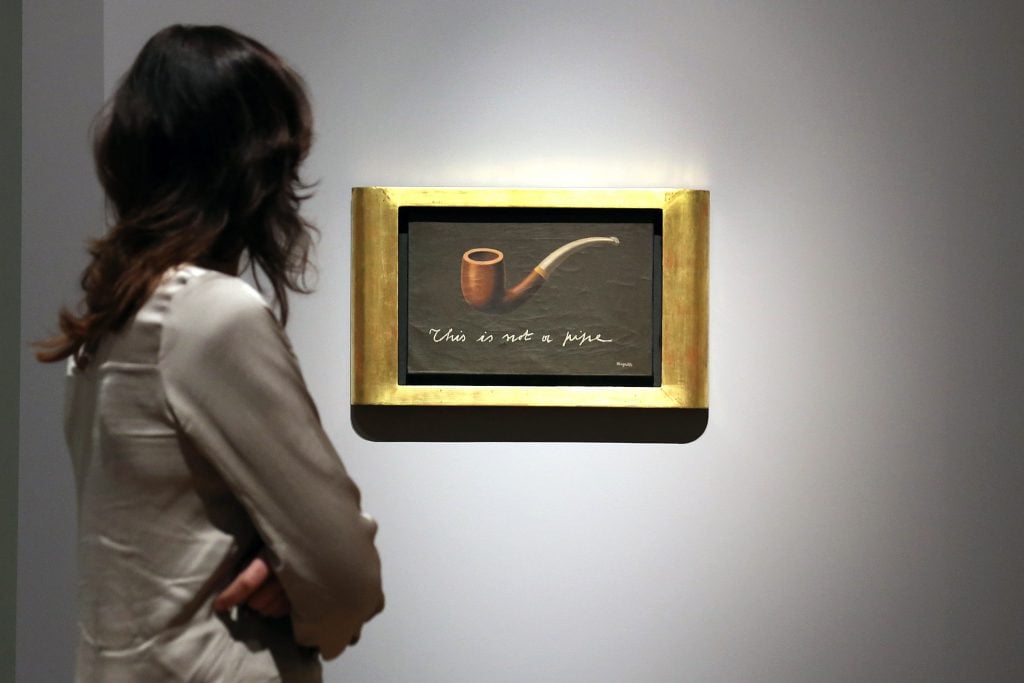Pop Culture
Art Behind the Meme: Magritte’s Pipe, Which Is Not a Pipe
The meme has been around so long that it has infiltrated other memes.

The meme has been around so long that it has infiltrated other memes.

Vittoria Benzine

The Treachery of Images (1929), by Belgian Surrealist René Magritte, is so ubiquitous that when X influencer @MNateShyamalan posted a supposed screen grab of Tucker Carlson yelling at the oil painting’s iconic pipe, many thousands of viewers assumed the doctored image was real. Magritte’s straightforward composition of a no-frills smoking apparatus accompanied by clean French script reading “this is not a pipe” illustrates the critical distinction between an image and its representation with impossible elegance. Pop culture was appropriating the painting and its message well before the internet appeared, but when the web did come around, The Treachery of Images became one of its earliest memes.
is this guy ok pic.twitter.com/NySjL3Rxzq
The best of Artnet News in your inbox.
— soul nate (@MNateShyamalan) February 2, 2023
Most early memes had consistent formats and straightforward titles. Meanwhile, memes today don’t get an actual title unless they get really big. Text inspired by The Treachery of Images appeared in the trailblazing Advice Animals meme, as well as the now legendary Rage Comic meme. Maybe you haven’t dared to remember Grumpy Cat in years, but there was a riff on Magritte’s work in one edition that read “This is not a meme.” There’s an edition of the Morpheus meme from the 2010s that reads, as is custom, “What if I told you—this is not a meme?”
Magritte’s artwork became its own meme, too, with results ranging from cute to political. One example places a marshmallow chick above French script stating “this is not a peep.” Sometimes Magritte’s pipe turns into Pepe, or Mario pops out of it.
This is not a group of pipe memes pic.twitter.com/vxYYfJYFln
— Kris Kneisley (@KneisGuy) May 2, 2021
Magritte got his start painting advertisements, and The Treachery of Images hails from a larger series of word-image paintings that the artist wrote a manifesto around. The painting now belongs to the Los Angeles County Museum of Art and is on view at that city’s Broad museum, where accompanying wall text calls it “a treatise on the impossibility of reconciling word, image, and object.” Magritte is one of history’s few artists who could have foreseen—even reveled in—the fact that this painting would go on to become perhaps the internet’s most widespread meme. So much so, in fact, that it’s not just a single fixed meme of its own, but one that infiltrates others.
Even in today’s infinitely fragmented meme scene, you’ll notice The Treachery of Images reappearing across widely circulated posts in ever more sly manners, including the Oblivious Anime Guy—a popular reaction image that went viral in 2018. The meme is based on an image of the hero from Taiyou no Yuusha Fighbird (1991) as he gestures towards a butterfly, asking, “Is this a pigeon?” In the Magritte edition, he’s gesturing towards Magritte’s pipe and asking, “Is this a pipe?”
i have transcended humor by combining rose mcgowan memes with rené magritte’s famous painting “This is Not a Pipe” pic.twitter.com/xD1vP0nKBl
— rocking femme (@imscreamign) March 5, 2019
Oblivious Anime Guy arose from Tumblr, where users say they play with JPEGs like they play with dolls, the way they make memes. Internet users are playing with The Treachery of Images in much the same manner, which would have delighted Magritte. JPEGs are not dolls, and dolls are not humans. The map is not the territory. The way The Treachery of Images exists in culture nearly 100 years after Magritte painted it shows that his adept commentary transcends time. It’s not a pipe—it’s something far more powerful.
What’s in a meme? Sometimes, art. Art Behind the Meme brings you the low-down on the artworks that have achieved our era’s finest and rarest feat: virality. Read on for how these art-historical works have been reimagined for the age of social media.